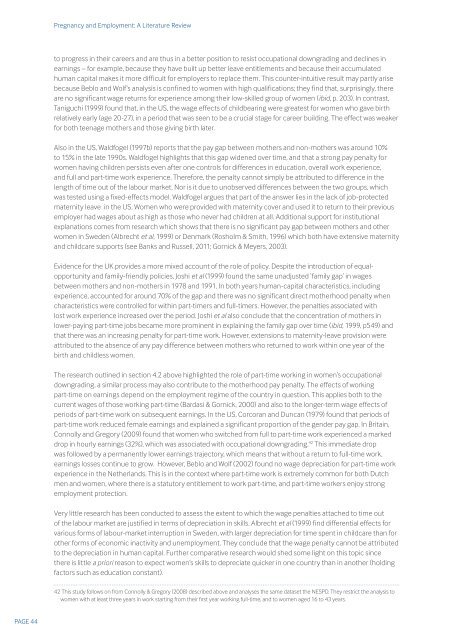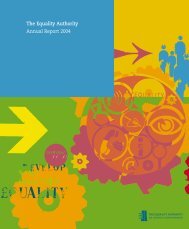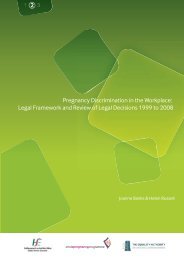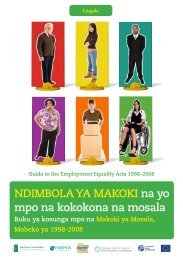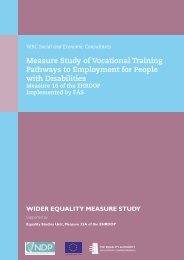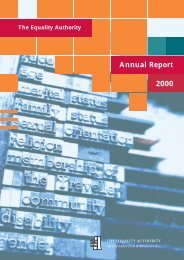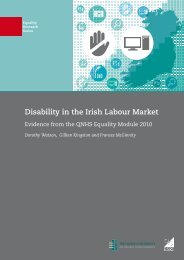Pregnancy and Employment: A Literature Review - Crisis Pregnancy ...
Pregnancy and Employment: A Literature Review - Crisis Pregnancy ...
Pregnancy and Employment: A Literature Review - Crisis Pregnancy ...
Create successful ePaper yourself
Turn your PDF publications into a flip-book with our unique Google optimized e-Paper software.
<strong>Pregnancy</strong> <strong>and</strong> <strong>Employment</strong>: A <strong>Literature</strong> <strong>Review</strong><br />
to progress in their careers <strong>and</strong> are thus in a better position to resist occupational downgrading <strong>and</strong> declines in<br />
earnings – for example, because they have built up better leave entitlements <strong>and</strong> because their accumulated<br />
human capital makes it more difficult for employers to replace them. This counter-intuitive result may partly arise<br />
because Beblo <strong>and</strong> Wolf’s analysis is confined to women with high qualifications; they find that, surprisingly, there<br />
are no significant wage returns for experience among their low-skilled group of women (ibid, p. 203). In contrast,<br />
Taniguchi (1999) found that, in the US, the wage effects of childbearing were greatest for women who gave birth<br />
relatively early (age 20-27), in a period that was seen to be a crucial stage for career building. The effect was weaker<br />
for both teenage mothers <strong>and</strong> those giving birth later.<br />
Also in the US, Waldfogel (1997b) reports that the pay gap between mothers <strong>and</strong> non-mothers was around 10%<br />
to 15% in the late 1990s. Waldfogel highlights that this gap widened over time, <strong>and</strong> that a strong pay penalty for<br />
women having children persists even after one controls for differences in education, overall work experience,<br />
<strong>and</strong> full <strong>and</strong> part-time work experience. Therefore, the penalty cannot simply be attributed to difference in the<br />
length of time out of the labour market. Nor is it due to unobserved differences between the two groups, which<br />
was tested using a fixed-effects model. Waldfogel argues that part of the answer lies in the lack of job-protected<br />
maternity leave in the US. Women who were provided with maternity cover <strong>and</strong> used it to return to their previous<br />
employer had wages about as high as those who never had children at all. Additional support for institutional<br />
explanations comes from research which shows that there is no significant pay gap between mothers <strong>and</strong> other<br />
women in Sweden (Albrecht et al, 1999) or Denmark (Rosholm & Smith, 1996) which both have extensive maternity<br />
<strong>and</strong> childcare supports (see Banks <strong>and</strong> Russell, 2011; Gornick & Meyers, 2003).<br />
Evidence for the UK provides a more mixed account of the role of policy. Despite the introduction of equalopportunity<br />
<strong>and</strong> family-friendly policies, Joshi et al (1999) found the same unadjusted ‘family gap’ in wages<br />
between mothers <strong>and</strong> non-mothers in 1978 <strong>and</strong> 1991. In both years human-capital characteristics, including<br />
experience, accounted for around 70% of the gap <strong>and</strong> there was no significant direct motherhood penalty when<br />
characteristics were controlled for within part-timers <strong>and</strong> full-timers. However, the penalties associated with<br />
lost work experience increased over the period. Joshi et al also conclude that the concentration of mothers in<br />
lower-paying part-time jobs became more prominent in explaining the family gap over time (ibid, 1999, p549) <strong>and</strong><br />
that there was an increasing penalty for part-time work. However, extensions to maternity-leave provision were<br />
attributed to the absence of any pay difference between mothers who returned to work within one year of the<br />
birth <strong>and</strong> childless women.<br />
The research outlined in section 4.2 above highlighted the role of part-time working in women’s occupational<br />
downgrading, a similar process may also contribute to the motherhood pay penalty. The effects of working<br />
part-time on earnings depend on the employment regime of the country in question. This applies both to the<br />
current wages of those working part-time (Bardasi & Gornick, 2000) <strong>and</strong> also to the longer-term wage effects of<br />
periods of part-time work on subsequent earnings. In the US, Corcoran <strong>and</strong> Duncan (1979) found that periods of<br />
part-time work reduced female earnings <strong>and</strong> explained a significant proportion of the gender pay gap. In Britain,<br />
Connolly <strong>and</strong> Gregory (2009) found that women who switched from full to part-time work experienced a marked<br />
drop in hourly earnings (32%), which was associated with occupational downgrading. 42 This immediate drop<br />
was followed by a permanently lower earnings trajectory, which means that without a return to full-time work,<br />
earnings losses continue to grow. However, Beblo <strong>and</strong> Wolf (2002) found no wage depreciation for part-time work<br />
experience in the Netherl<strong>and</strong>s. This is in the context where part-time work is extremely common for both Dutch<br />
men <strong>and</strong> women, where there is a statutory entitlement to work part-time, <strong>and</strong> part-time workers enjoy strong<br />
employment protection.<br />
Very little research has been conducted to assess the extent to which the wage penalties attached to time out<br />
of the labour market are justified in terms of depreciation in skills. Albrecht et al (1999) find differential effects for<br />
various forms of labour-market interruption in Sweden, with larger depreciation for time spent in childcare than for<br />
other forms of economic inactivity <strong>and</strong> unemployment. They conclude that the wage penalty cannot be attributed<br />
to the depreciation in human capital. Further comparative research would shed some light on this topic since<br />
there is little a priori reason to expect women’s skills to depreciate quicker in one country than in another (holding<br />
factors such as education constant).<br />
42 This study follows on from Connolly & Gregory (2008) described above <strong>and</strong> analyses the same dataset the NESPD. They restrict the analysis to<br />
women with at least three years in work starting from their first year working full-time, <strong>and</strong> to women aged 16 to 43 years.<br />
PAGE 44


